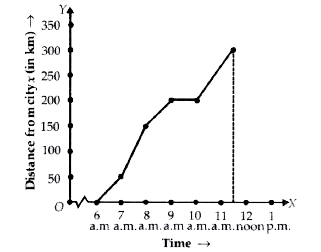A courier-person cycles from a town to a neighboring suburban area to deliver a parcel to a merchant. His distance from the town at different times is shown by the following graph.
(a) What is the scale taken for the time axis?
(b) How much time did the person take for the travel?
(c) How far is the place of the merchant from the town?
(d) Did the person stop on his way? Explain.
(e) During which period did he ride fastest?

i. The scale taken for the time axis is 4 unit=1 hour or 1unit=15minutes.
ii. Total time of travel of the person =14×15=210minutes=3hours 30minutes
iii. Clearly, The distance from the town to the merchant place is22km.
iv. Yes, the person stopped on his way during the time interval 10a.m. to 10:30a.m. as indicated by the horizontal line on the graph.
v. During 8a.m. to 9a.m. period he rode the fastest.
Topper's Solved these Questions
- INTRODUCTION TO GRAPHSBOOK - NCERTCHAPTER - INTRODUCTION TO GRAPHSEXERCISE - SOLVED EXAMPLES
8 Videos
- INTRODUCTION TO GRAPHSBOOK - NCERTCHAPTER - INTRODUCTION TO GRAPHSEXERCISE - EXERCISE 15.3
2 Videos
- FACTORISATIONBOOK - NCERTCHAPTER - FACTORISATIONEXERCISE - EXERCISE 14.4
21 Videos
- LINEAR EQUATIONS IN ONE VARIABLEBOOK - NCERTCHAPTER - LINEAR EQUATIONS IN ONE VARIABLEEXERCISE - EXERCISE 2.3
9 Videos
Similar Questions
A courter-person cycles from a town to a neighbouring suburban area to deliver a parcel to a merchant. His distances from the twon at different times are shown by the given graph.

Study the above graph carefully and answer the questions given below:
(i) What is the scale taken for the time-axis?
(ii) How much time did the person take for the travel ?
(iii) How far is the place of the merchant from the town ?
(iv) Did the person stop on his way ? Explain.
(v) During which period did he ride fastest ?
View SolutionWhat steps did the British take to defend the towns after the revolt of 1857?
View Solution
Knowledge Check
A car travels a certain distance from town A to town B at the speed of 42 km/h and from town B to town A at a speed of 48 km/h. What is the average speed of the car?
A45km/hB46km/hC44km/hD44.8 km/hWhy couldn't the merchants expand production within towns ?
AThe powerful guilds did not allow them to do soBNew merchants were not competent enough to carry on production work and tradeCNew merchants had inadequate capitalDCompetent weavers and artisans were not available in townsHow did spices, muslin and other merchandise were taken from India to different countries in ancient times?
AThrough oceansBThrough airCThrough various passes across the mountainsDNone of the above
Suppose you are standing on a tall ladder. If your distance from the centre of the earth is 2 R, what will be your weight ?
View SolutionA person travels by a car at a speed of 180kmh−1 . It takes exactly 10 hours by his wristwatch to go from the station A to the station B . (a) What is the rest distance between the two stations ? (b) How much is taken in the road frame by the car to go from the station A to the station B?
View SolutionThe given graph describes the distances of a car from a city X at different times when it is travelling from City X to City Y, which are 300 km apart. Study the graph and answer the following:
(i) What information is given on the two axes?
(ii) From where and at what time did the car begin its journey?
(iii) How far did the car go in the first hours?
(iv) Did the car stop for some duration at any place? Justify your answer
(v) Was the speed same during the first three hours? How do you know it?
(vi) When did the car reach City Y?

View SolutionStudy the distance-time graph given below for a car to travel to certain places and answer the questions that follow.
(a) How far does the car travel in 2 hours?
(b) How much time does the car take to reach R?
(c) How long does the car take to cover 80 km?
(d) How far is Q from the starting point?
(e) When does the car reach the place S after starting?

View Solution.“You have an interesting face”- Who said this and to whom? How did the person speaking react? How did the speaker correct his comment?
View Solution
